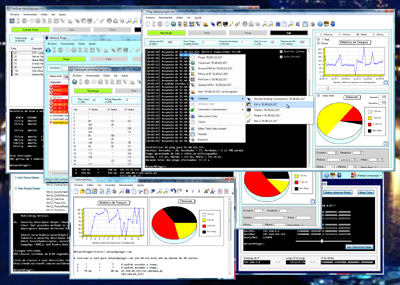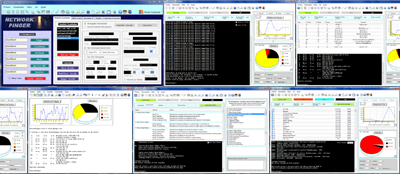Welcome to the Network Pinger freeware!

About Network Pinger
Network Pinger is a network monitoring freeware, for systems with the .Net framework installed, like Windows™ for example. This freeware has as features:
- Innovating and intuitive interface;
- Mass pings with automatic extraction of hosts;
- Automated browsing;
- Pings to single hosts;
- Traceroutes;
- Port scans;
- WMI queries;
- Whois to domain names and IPs;
- Name resolution;
- IP calculator;
- Real time charts and statistics;
- Report creation and printing;
- Integration with other softwares;
- Host extraction from memory with a single click;
- Host list creation with network masks;
- Text editor with embedded tools;
- User-defined commands;
- Configurable Multithreading;
- Optimized for best performance;
- Among others...

Network Pinger objectives
Still a decade ago only a few persons would dare to install new memory on a computer. Nowadays any child would install an entire computer from scratch, after all it's like assembling a toy. With pings, traceroutes and such, still nowadays the majority of users is kept away from the command line shells and text mode commands as ping, or understand what words like TTL mean, etc. The most natural evolution would be that soon any child will know how to use these tools, but they will probably be available to them in other more graphical and visual ways, and not in text mode command line like before.
This software already tries to be a part of that evolutionary jump, and shows all commands in a graphical and pleasant way, and in the best way of presenting its results: charts. Who will investigate through 30,000 responses from a ping that lasted hours, one by one? Nobody, as it would take us a lot of time, and it would be a very heavy work. But in a simple chart, we can see the evolution during those 30,000 pings made, their peaks and bottoms, in just a second. We just need to look at the chart and that's it. That's the natural evolution of tools like the simple Ping tool. Run it, and watch its results in a graphical way, whether in line charts or pie charts, without ignoring its predecessor: the command line, which will always be present. That's the way all the network tools of the future are, easy to interpret and accessible to all.
How it all began...
This project was originally born from the necessity to have a mass pinger tool with an automated browsing capability. This because of its developer having worked in an ISP some time ago, and had to do lots of times, a boring operation consisting in opening a web page, where a specific group of clients would be chosen, to receive a HTML table with a list of IPs and other data, and then to extract from that list only the IPs, having to filter them, copying them, and pasting them in some mass pinging software.
This was a really boring, tiring and painful process, as well as time consuming and being prone to cause mistakes. Its developer also needed a customizable and automated system for his personal use to monitor and test his multiple servers from home. This way its developer decided to program a mass pinging software from scratch in his free time, that would be able to extract the list of possible options given by a HTML page, present them on screen and select them automatically on the real page when necessary in a few time, to give the list of hosts to the user without him having the necessity to open the page himself, on in other words, a mass pinger with an automated browsing capability.
With time, during its development, some visual improvements appeared, some easy reading charts, file saving capability, printing, editing, and because of daily basis needs, its developer decided to create in the same way some individual tools, like ping, traceroute, port scanner, whois, dns, WMI queries, and even an IP calculator for network creation. An integration with remote connection softwares like Putty was added for the developer to be able to connect to his servers directly in an easy and quick way, custom commands for the user to be able to execute other softwares, possibility to customize and save sessions for quick execution of common tasks, etc.
With all these constant improvements, the initially simple mass pinging tool with automated browsing, has become something much more complete, deciding this way its developer that everybody on the Internet should be able to download this application as freeware and be able to use it for free on their daily basis also. This way this software that gave its developer so much work to make, could be useful to a lot of others also, to automate their tasks, which was something that its developer wasn't able to find in the Internet until that date, specially for free. This way maybe it could also be some sort of way to obtain feedback about the software, some new ideas for the future, and possibly some bugs. And who knows? Maybe this project would one day be even more complete. At the moment its developer is developing other projects at the same time, and doesn't know when he will make a new version of it, but ideas and feedbacks will always be accepted, as well as general opinions, and it was also created a forum for the exchange of ideas, but the guestbook could be used for that also.

Example of a possible utilization
An example of how the browsing automation could be useful? Lets imagine that a company, like an ISP for example, that has thousands of clients with its modems spread on many "cells" through the country. There is a company HTML page that says how many modems are registered or not in a given time, but sometimes there may be an indication of all modems being registered, but their owners not being able to navigate anyway, or in other words, modems registered but blocked and without access to the Internet for some reason, and in that moment the best thing to do would be a simple ping of 1 or 2 or 3 packets to all the users of a given "cell" to see if they are all really online or not.
Now, this ping would need to be done individually and not in a main server. Why? Lets imagine 100 users making 3 pings alone, to a cell with 10,000 clients at the same time, it would be around 3,000,000 pings that the main server would have to do simultaneously. So, it is not the best option. So each user should make his own ping on his/her computer. But it would be also bad to force those users to open a single web page, chose the "cell" with the mouse, submit the form, wait for it to open a new page with the results after the query on the main server, copy the results, filter the IPs from the results page, remove the spaces and unwanted chars, etc, until at last be able to paste everything in some sort of mass ping software and pray for it not to crash while doing the mass ping later.
With Network Pinger, there are only two steps: chose the cell on the software interface, being easy to find any cell in the middle of 10,000 easily (see the tutorial), and click on the start mass pings button, and that's it. The software will do everything itself, browsing, choosing the options, submitting the forms, downloading the results, filter them, soft them, ping them, everything. All in a very simple way, quickly and effective.
This process is explained in the tutorial. There are many possible utilizations for this software and advantages, and it will be up to the user to find them with time. This software is useful also to allow users that are new to these tools to make these kind of operations as a single "ping" in an easy and intuitive way.
Have some nice pings!
Windows is a registered trademark of Microsoft™ Corporation.
|
|
|